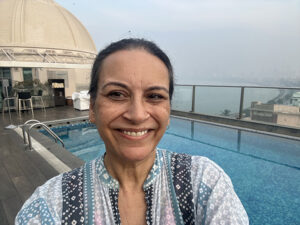This post originally appeared on Murder Is Everywhere.
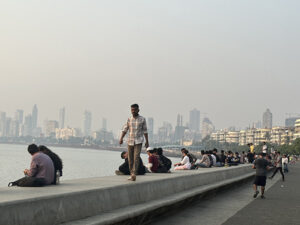
It was just 4:30 in the morning when my husband Tony and I arrived in Mumbai on a middle-of-the-night flight from Kochi. I was tired, but not too tired to notice that Mumbai’s domestic terminal had really spiffed up its décor, restrooms and shops. It was easy to reach the baggage claim area where our suitcases had already arrived. This was quite different from waits of 30 minutes to an hour for baggage at some US airports recently. Luggage on a cart, we made our way down an escalator and while Tony was in the restroom, I approached a counter where one could pre-pay for licensed taxi rides.
I’d used the prepaid taxi service before from this airport, but it was an upgrade to find the booking counter in the air conditioned terminal. To my surprise, the dispatcher asked if I would accept having a “lady taxi driver.” It turned out that this was another innovation. After I heartily agreed and paid the fee, and he’d written down my destination on the voucher, Tony and I walked toward the taxi zone in the covered area for vehicles nearby. As we approached the designated parking spot, we heard a furious, yelling argument. Traveling deeper into the female cabdrivers’ zone, we found two women facing off and shaking fists at each other. One had short hair, a tight white T-shirt and jeans rolled to a cropped length ala James Dean, while the other had longer hair and wore an Indian kurti top and jeans. Their styles varied, but they both looked tough as hell. It was a sight straight out of a movie, but the gender of the players was a surprise.
The fight had drawn a lot of attention: not only the other lady drivers who were shouting encouragement to both sides, but also male taxi drivers who had deserted their parking spots to observe. Yet our designated driver was sound asleep in her car. After I knocked on the window, she groggily emerged, helped load the luggage, and took the voucher. As the taxi rolled out of the garage, the fighters parted, with peace in the garage restored.
We quickly sped off to the Hotel Intercontinental on Marine Drive. I longed to ask our driver if she knew the reason for the ladies’ fight, but the language gap was too vast. She was listening to our English conversation, though, and she chuckled at our surprise at the emptiness of the Bandra-Worli Sealink Road, which is usually packed. Because the sky was just lightening over the Arabian Sea, and the buildings were lit up, it made for spectacular views. Chalo! A car trip that normally might take one-and-a-half to two hours in daytime was just 35 minutes.
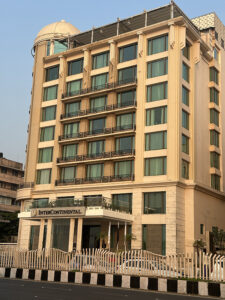
We pulled up to a small, cream-colored hotel with a curved side and glowing windows. This was the Intercontinental Marine Drive, our comfortable home for the next eight nights. I had been nervous about staying at a hotel that was not one of the city’s go-to big names, but I was delighted by the decor, service, and how small and manageable it was: just 59 rooms and eight stories high. Somehow, it felt more like staying in a nice condo building than a hotel.
Due to its location in the UNESCO-designated historic art deco district, the Intercontinental had to fit in with the surrounding 1930s neighbor buildings. Thus, the fully modern building was designed with one rounded side and a short turret on top, right next to the rooftop swimming pool. We stayed on the fifth floor, and the exterior of the suite was a long, curved wall of glass windows showing a triple-sided view of the water and Marine Drive. Standing in our room, gazing out at the breathtaking sunrise, I caught sight of a slowly growing number of people people jogging, walking, and doing group yoga and calisthenics. The Marine Drive promenade is bordered by a short wall that’s perfect for sitting; and here were many couples and student pals and retirees enjoying intimate time as the city woke up.
Truly, Marine Drive is the face of Mumbai you see in Bollywood rom-coms.
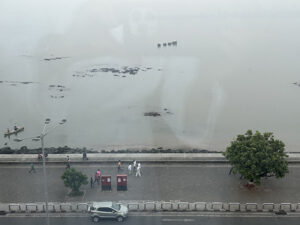
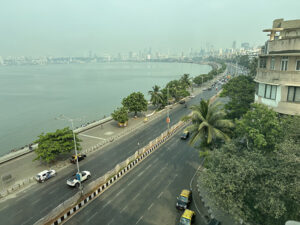
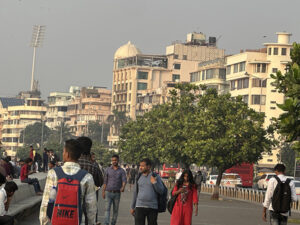
In my opinion, Marine Drive is one of the most beautiful places in Mumbai, but in the past, it was only a drive-by zone for me on the way to Malabar Hill or the Sealink. The district is a short distance from Colaba, Mumbai’s crowded tourist zone. No hawkers are here, also no tourists nor shops selling sandals and beads. Which makes it all the more relaxing.
The roadway was built in 1915-1920 from reclaimed land from Bombay’s Back Bay. Originally the roadway was called Kennedy Sea-Face Road in honor of Sir Michael Kennedy, the colonial officer who headed the city’s Public Works Department, but it was nicknamed the Queen’s Necklace because of the sparkling sight of street lamps along the bay, as viewed from the other side of the water.
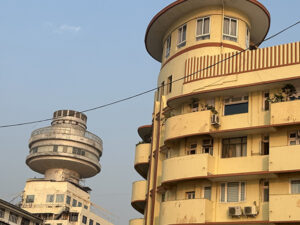
During the late 1920s and 1930s, the debut crop of young Indian architects wanted to dissociate themselves from the Gothic Saracenic architecture of colonialism. These architects were hired by developers wanting to create residential housing for the Indian elite on Marine Drive. What they designed were posh apartment buildings in the Art Deco style with a Bombay touch. As I wandered along the stretch, I saw the touch manifested in oddly shaped windows that looked like ancient Egyptian aesthetic eyes—or maybe ocean liner cabin windows with some extra trimming? And how about the turrets which managed to sometimes look Eastern, and other times industrial or straight out of science fiction? How exciting these years must have been for creative people in the city.
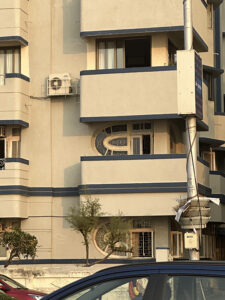
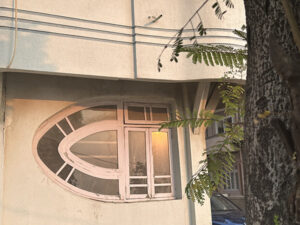
Still, Marine Drive isn’t only a residential district. Within five minutes of the hotel, we could walk to a few shops and banks, some more colleges, a nearby train station, Churchgate. Two blocks away was Veer Nariman Road, which has a few hotels, including the Ambassador with its splendid turret that used to rotate; several good restaurants including an Asian fusion spot, Foo, where I had dinner three times; and a beloved ice cream parlor called Rustom’s that I regretfully missed. The most famous hotspot off Marine Drive might very well be Brabourne Stadium, which was bustling and creating its own street scene during two World Cup cricket qualifying matches held there during early November. One night we came into the hotel to find excited guests in the lobby with faces painted supporting the Indian cricket team. Victory!
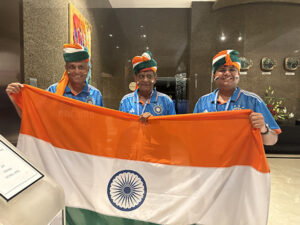
Because he was truly on vacation, Tony got to enjoy more time in Churchgate than I did. I’d come to Mumbai for meetings and site research. My days in Mumbai were filled with drives to various parts of South Bombay and its near suburbs for book research, and out farther on some days to places like Santa Cruz and Chemmur to meet film executives interested in The Widows of Malabar Hill. All very exciting, but more hours were spent in the car than the offices. I never had imagined that one could get sciatica from just being a car passenger, but it happened to me. The pleasant company of Mr. Sonu Rekhi, the outspoken and friendly driver who transported me during these eight days, was diverting.
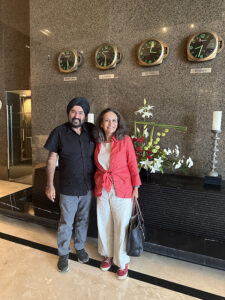
The first day I traveled for Bollywood purposes, Sonu and I set off at eight a.m., arriving at ten-thirty for an eleven o’clock meeting. I didn’t return to my hotel until eight, and that was only because my agent kindly postponed the day’s last meeting. But as I left the darkness of Marine Drive and stepped into my hotel room, the telephone on my desk trilled.
The hotel concierge was on the line, asking if I would accept a free in-room massage. Was I hearing that right? I learned that a brother-sister team of massage therapists would be willing to give both me and my husband head and foot massages. Of course I said yes, and half an hour later, my head and my toes felt as if they had been reborn. A lasting connection was made; as I spent my days doing interviews, my husband made sure to book a (paid) massage for himself with the Massage Brother almost every day (in between his walks and museum-going). We came to really know and like the hotel staff, and it was quite easy to get acquainted with familiar with people who knew our favorite table and our coffee styles.
Over the years, I’ve stayed in a few different places in Mumbai’s neighborhoods. These spots have included a family home, a private club, an Airbnb, and three different hotels. All of these experiences have offered their own special opportunities. This particular stay became all the sweeter because my friend Sifra, a historian who helped me with my last book, lives with her husband in the art deco apartment building closest to the hotel. Sometimes, when I was awake early in the morning at the writing desk, I’d look out my window toward her apartment building to see if her lights were on yet. Sifra could step over at a moment’s notice for a breakfast meeting, and we could arrive to her flat speedily, too. And it was this surprise proximity that made our friendship deepen and Churchgate feel like home.
